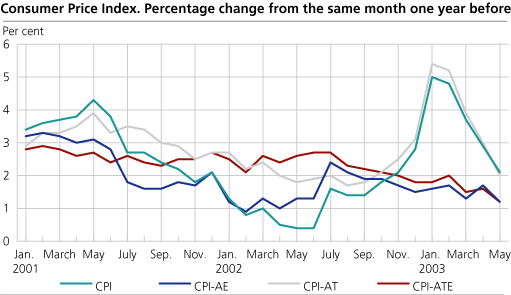Content
Published:
This is an archived release.
Energy products caused CPI-decline
The Consumer Price Index (CPI) fell by 0.5 per cent from April to May. The decrease was mainly due to the price development of energy products, which also explains the fall in the year-to-year change in the CPI from 2.9 per cent in April to 2.1 per cent in May. The CPI adjusted for tax changes and excluding energy products (CPI-ATE) was 1.2 per cent.
The CPI stood at 112.3 (1998=100) in May this year in comparison with 110.0 in May last year.
The consumer prices down 0.5 per cent from April to May
The tariffs on electricity have during the last months caused a strong drop in the consumer prices and in May the prices continued to decline by 9.1 per cent. From January the prices have fallen by 39.3 per cent. The petrol prices continued to fall in May and showed a decrease of 5.9 per cent.
The prices of accommodation services declined by 2.4 per cent and contributed to the decrease in the CPI from April to May, as did lower prices of audiovisual equipment.
The food prices on the other hand, went up by 0.4 per cent in May mainly due to higher prices of fresh fruit. Especially the prices of oranges showed a strong price increase. The prices of alcoholic beverages also increased in May by 0.4 per cent.
Year-to-year change: Tariffs on electricity contributed to price growth
The CPI increased by 2.1 per cent from May 2002 to May 2003. Despite the fact that the tariffs on electricity have declined every month since February, the tariffs were 29.6 per cent higher in May this year compared with the same period last year. The tariffs on electricity are thus still the main single contributor to the growth in the consumer prices. During the last 12 months the CPI excluding electricity has increased by 1.1 per cent.
An increase in the costs of owner-occupied housing and actual rentals by 4.3 and 4.2 per cent respectively from May last year to May this year contributed to the growth in the consumer prices as well.
The prices of food went up by 3.5 per cent during the last 12 months. The price increase covers particularly some products of bread and cereals, dairy products, in addition to fresh vegetables.
Higher insurance premiums have also contributed to the year-to-year growth in the consumer prices. The same applies to the prices of services and different commodities connected to culture and recreation together with health services.
The prices of clothing and footwear as a total have declined by 11.5 per cent since May last year. The prices of clothing decreased the most by 12.2 per cent, while the prices of footwear went down by 6.8 per cent. In contrast to earlier this year, the petrol prices contributed to moderate the growth in the consumer prices in May with a price decrease of 2.8 per cent. In addition, a decline in the prices of audiovisual- and telephone equipment was registered on a year-to-year basis.
Change in the year-to-year growth: Energy products contributed to price decline
The year-to-year growth in the CPI went from 2.9 per cent in April to 2.1 per cent in May. The decline in the year-to-year growth was mainly caused by the price development of energy products. The tariffs on electricity dropped, as mentioned above, by 9.1 per cent in May this year, in comparison to a marginal decline in May last year. The prices of petrol fell by 5.9 per cent in May this year while the prices decreased by 2.5 per cent last year. Also the prices of clothing, telephone services as well as rentals contributed to the decline in the year-to-year growth.
The CPI adjusted for tax changes (CPI-AT) dropped from 3.0 per cent in April to 2.0 per cent in May. The CPI-ATE fell from 1.6 per cent to 1.2 per cent in the same period.
| The Consumer Price Index. 1998=100 |
| Index | Change in per cent | ||||||||||||||||||||||||||||||||||||||
|---|---|---|---|---|---|---|---|---|---|---|---|---|---|---|---|---|---|---|---|---|---|---|---|---|---|---|---|---|---|---|---|---|---|---|---|---|---|---|---|
| May 2003 | April 2003-May 2003 | May 2002- May 2003 | January-May 2002-January-May 2003 | ||||||||||||||||||||||||||||||||||||
| CPI All-item index | 112.3 | -0.5 | 2.1 | 3.7 | |||||||||||||||||||||||||||||||||||
| Food and non-alcoholic beverages | 104.1 | 0.3 | 3.3 | 3.1 | |||||||||||||||||||||||||||||||||||
| Alcoholic beverages and tobacco | 115.1 | 0.3 | 1.8 | 1.6 | |||||||||||||||||||||||||||||||||||
| Clothing and footwear | 82.6 | 0.2 | -11.5 | -9.1 | |||||||||||||||||||||||||||||||||||
| Housing, water, electricity, fuels | 126.4 | -1.6 | 7.5 | 12.2 | |||||||||||||||||||||||||||||||||||
| Furnishings household equipment | 102.7 | 0.2 | -0.8 | -0.7 | |||||||||||||||||||||||||||||||||||
| Health | 119.7 | - | 3.5 | 3.9 | |||||||||||||||||||||||||||||||||||
| Transport | 113.2 | -1.2 | 0.3 | 1.6 | |||||||||||||||||||||||||||||||||||
| Communications | 86.9 | -0.2 | -3.3 | -0.5 | |||||||||||||||||||||||||||||||||||
| Recreation and culture | 106.6 | -0.2 | 0.8 | 0.8 | |||||||||||||||||||||||||||||||||||
| Education | 132.0 | - | 5.1 | 5.1 | |||||||||||||||||||||||||||||||||||
| Restaurants and hotels | 119.2 | -0.1 | 3.1 | 3.2 | |||||||||||||||||||||||||||||||||||
| Miscellaneous goods and services | 118.9 | - | 3.7 | 3.6 | |||||||||||||||||||||||||||||||||||
| CPI-AE | 110.4 | - | 1.2 | 1.5 | |||||||||||||||||||||||||||||||||||
| CPI-AT | -0.6 | 2.0 | 3.9 | ||||||||||||||||||||||||||||||||||||
| CPI-ATE | 0.1 | 1.2 | 1.6 | ||||||||||||||||||||||||||||||||||||
Contact
-
Statistics Norway's Information Centre
E-mail: informasjon@ssb.no
tel.: (+47) 21 09 46 42
-
Konsumprisindeksen
E-mail: konsumprisindeksen@ssb.no
tel.: (+47) 62 88 56 34
-
Camilla Rochlenge
E-mail: camilla.rochlenge@ssb.no
tel.: (+47) 40 90 23 72
-
Kjersti Nyborg Hov
E-mail: kjersti.nyborg.hov@ssb.no
tel.: (+47) 40 90 23 63
-
Gunnar Larsson
E-mail: gunnar.larsson@ssb.no
tel.: (+47) 40 90 26 79
-
Trym Kristian Økland
E-mail: trym.okland@ssb.no
tel.: (+47) 46 81 09 15

